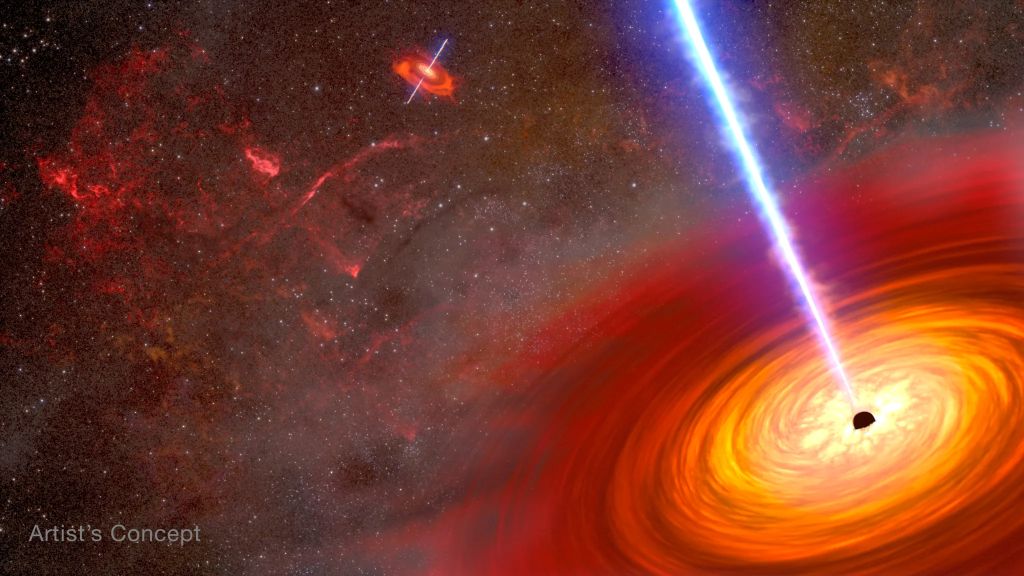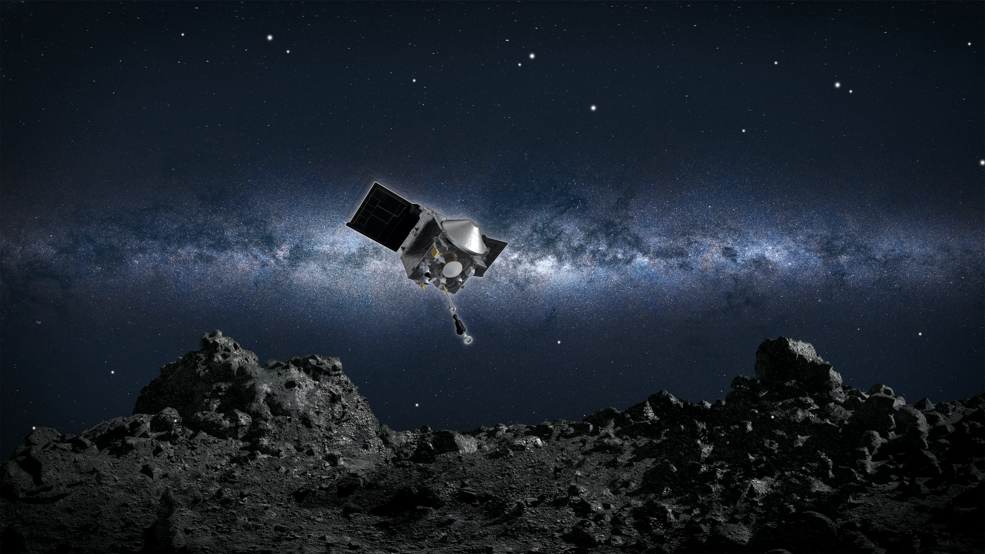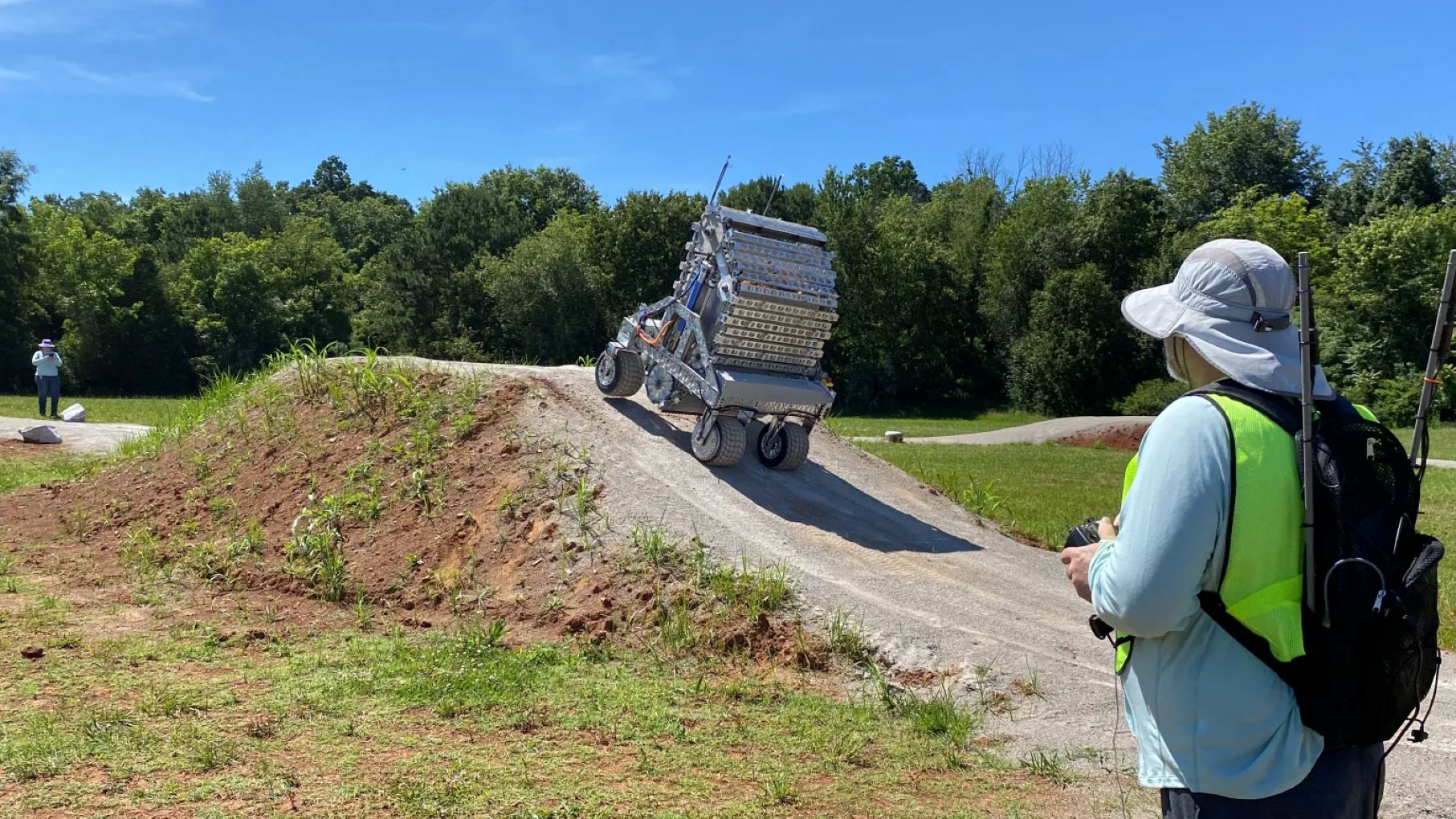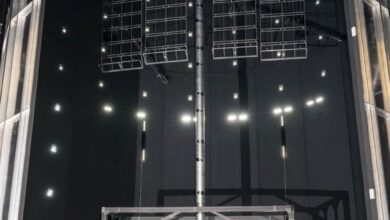NASA’s Hubble, Chandra Find Supermassive Black Hole Duo

Download this artist’s depiction
Like two Sumo wrestlers squaring off, the closest confirmed pair of supermassive black holes have been observed in tight proximity. These are located approximately 300 light-years apart and were detected using NASA’s Hubble Space Telescope and the Chandra X-ray Observatory. These black holes, buried deep within a pair of colliding galaxies, are fueled by infalling gas and dust, causing them to shine brightly as active galactic nuclei (AGN).
This AGN pair is the closest one detected in the local universe using multiwavelength (visible and X-ray light) observations. While several dozen “dual” black holes have been found before, their separations are typically much greater than what was discovered in the gas-rich galaxy MCG-03-34-64. Astronomers using radio telescopes have observed one pair of binary black holes in even closer proximity than in MCG-03-34-64, but without confirmation in other wavelengths.
AGN binaries like this were likely more common in the early universe when galaxy mergers were more frequent. This discovery provides a unique close-up look at a nearby example, located about 800 million light-years away.

A Hubble Space Telescope visible-light image of the galaxy MCG-03-34-064. Hubble’s sharp view reveals three distinct bright spots embedded in a white ellipse at the galaxy’s center (expanded in an inset image at upper right). Two of these bright spots are the source of strong X-ray emission, a telltale sign that they are supermassive black holes. The black holes shine brightly because they are converting infalling matter into energy, and blaze across space as active galactic nuclei. Their separation is about 300 light-years. The third spot is a blob of bright gas. The blue streak pointing to the 5 o’clock position may be a jet fired from one of the black holes. The black hole pair is a result of a merger between two galaxies that will eventually collide.
NASA, ESA, Anna Trindade Falcão (CfA); Image Processing: Joseph DePasquale (STScI)
The discovery was serendipitous. Hubble’s high-resolution imaging revealed three optical diffraction spikes nested inside the host galaxy, indicating a large concentration of glowing oxygen gas within a very small area. “We were not expecting to see something like this,” said Anna Trindade Falcão of the Center for Astrophysics | Harvard & Smithsonian in Cambridge, Massachusetts, lead author of the paper published today in The Astrophysical Journal. “This view is not a common occurrence in the nearby universe, and told us there’s something else going on inside the galaxy.”
Diffraction spikes are imaging artifacts caused when light from a very small region in space bends around the mirror inside telescopes.
Falcão’s team then examined the same galaxy in X-rays light using the Chandra observatory to drill into what’s going on. “When we looked at MCG-03-34-64 in the X-ray band, we saw two separated, powerful sources of high-energy emission coincident with the bright optical points of light seen with Hubble. We put these pieces together and concluded that we were likely looking at two closely spaced supermassive black holes,” said Falcão.
https://youtube.com/watch?v=2VUw36ukuQ0%3Ffeature%3Doembed%26enablejsapi%3D1%26origin%3Dhttps%3A
In a surprise finding, astronomers, using NASA’s Hubble Space Telescope have discovered that the jet from a supermassive black hole at the core of M87, a huge galaxy 54 million light years away, seems to cause stars to erupt along its trajectory. The stars, called novae, are not caught inside the jet, but in a dangerous area near it.
NASA’s Goddard Space Flight Center; Lead Producer: Paul Morris
To support their interpretation, the researchers used archival radio data from the Karl G. Jansky Very Large Array near Socorro, New Mexico. The energetic black hole duo also emits powerful radio waves. “When you see bright light in optical, X-rays, and radio wavelengths, a lot of things can be ruled out, leaving the conclusion these can only be explained as close black holes. When you put all the pieces together it gives you the picture of the AGN duo,” said Falcão.
The third source of bright light seen by Hubble is of unknown origin, and more data is needed to understand it. That might be gas that is shocked by energy from a jet of ultra high-speed plasma fired from one of the black holes, like a stream of water from a garden hose blasting into a pile of sand.
“We wouldn’t be able to see all of these intricacies without Hubble’s amazing resolution,” said Falcão.
The two supermassive black holes were once at the core of their respective host galaxies. A merger between the galaxies brought the black holes into close proximity. They will continue to spiral closer together until they eventually merge — in perhaps 100 million years — rattling the fabric of space and time as gravitational waves.
The National Science Foundation’s Laser Interferometer Gravitational-Wave Observatory (LIGO) has detected gravitational waves from dozens of mergers between stellar-mass black holes. But the longer wavelengths resulting from a supermassive black hole merger are beyond LIGO’s capabilities. The next-generation gravitational wave detector, called the LISA (Laser Interferometer Space Antenna) mission, will consist of three detectors in space, separated by millions of miles, to capture these longer wavelength gravitational waves from deep space. ESA (European Space Agency) is leading this mission, partnering with NASA and other participating institutions, with a planned launch in the mid-2030s.
NASA’s Marshall Space Flight Center manages the Chandra program. The Smithsonian Astrophysical Observatory’s Chandra X-ray Center controls science from Cambridge, Massachusetts and flight operations from Burlington, Massachusetts. Northrop Grumman Space Technologies in Redondo Beach, California was the prime contractor for the spacecraft.
The Hubble Space Telescope has been operating for over three decades and continues to make ground-breaking discoveries that shape our fundamental understanding of the universe. Hubble is a project of international cooperation between NASA and ESA (European Space Agency). NASA’s Goddard Space Flight Center in Greenbelt, Maryland, manages the telescope and mission operations. Lockheed Martin Space, based in Denver, Colorado, also supports mission operations at Goddard. The Space Telescope Science Institute in Baltimore, Maryland, which is operated by the Association of Universities for Research in Astronomy, conducts Hubble science operations for NASA.





